Swinburne EDU20002: Mathematics in Practice Assignment 2 Report
VerifiedAdded on 2022/09/07
|12
|2269
|15
Report
AI Summary
This report, prepared for the EDU20002 Mathematics in Practice course at Swinburne University, analyzes two teaching resources designed to foster early mathematical thinking in children aged 3-4. The assignment fulfills the requirements to select two areas of mathematical thinking, counting and measuring, and two resources for each. The first resource analyzed is a YouTube video titled "My Magic Numbers" which teaches counting skills through an engaging animated story. The second resource is a non-ICT activity focusing on hand measurement using paper clips, which helps children develop measurement skills. Both resources are evaluated based on their appropriateness, curriculum links to the Australian Curriculum and Early Years Learning Framework, and recommended teaching strategies. The report emphasizes the importance of creative and engaging resources for developing numeracy skills, especially in early childhood education, and provides a detailed analysis of how each resource aligns with the learning objectives.
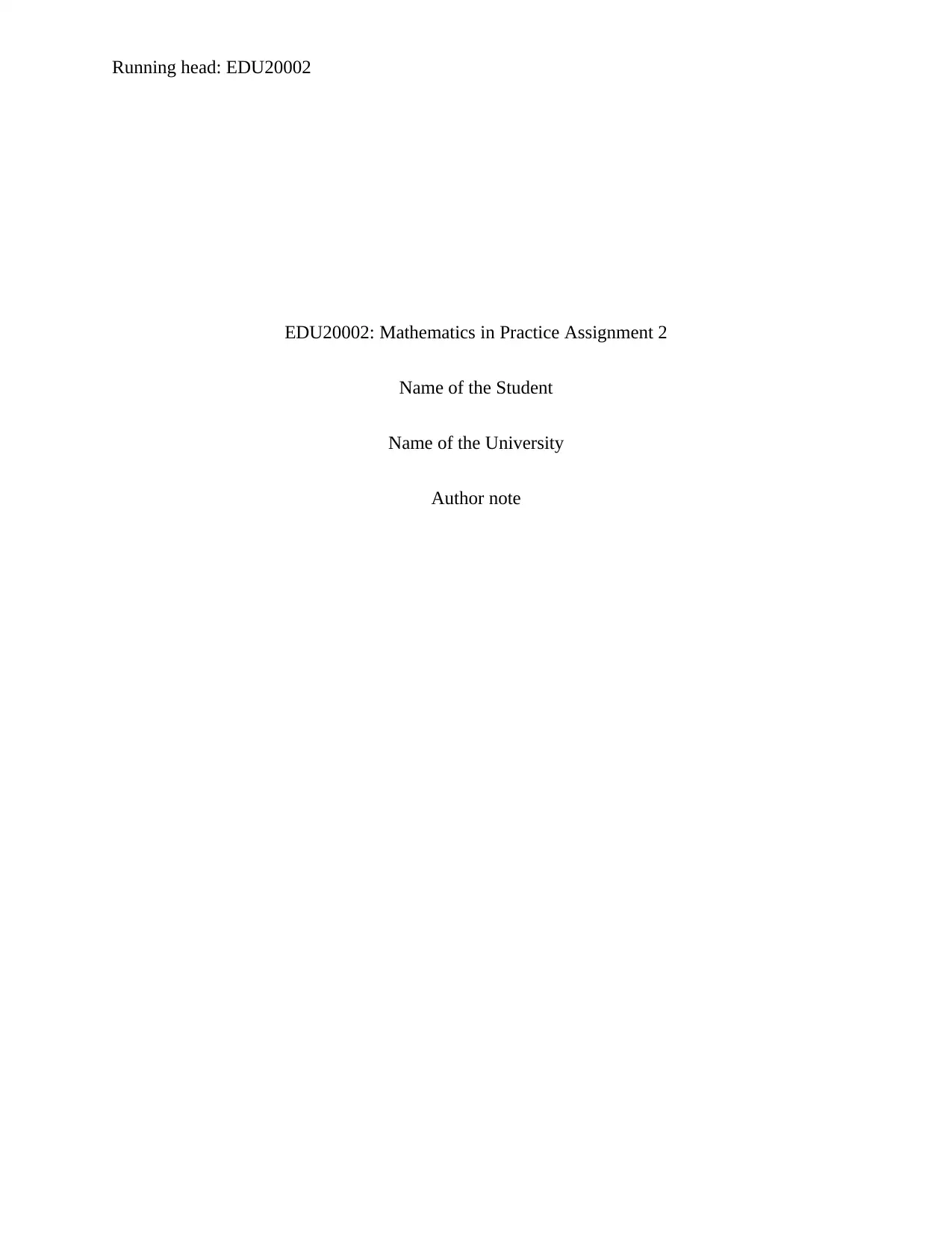
Running head: EDU20002
EDU20002: Mathematics in Practice Assignment 2
Name of the Student
Name of the University
Author note
EDU20002: Mathematics in Practice Assignment 2
Name of the Student
Name of the University
Author note
Paraphrase This Document
Need a fresh take? Get an instant paraphrase of this document with our AI Paraphraser
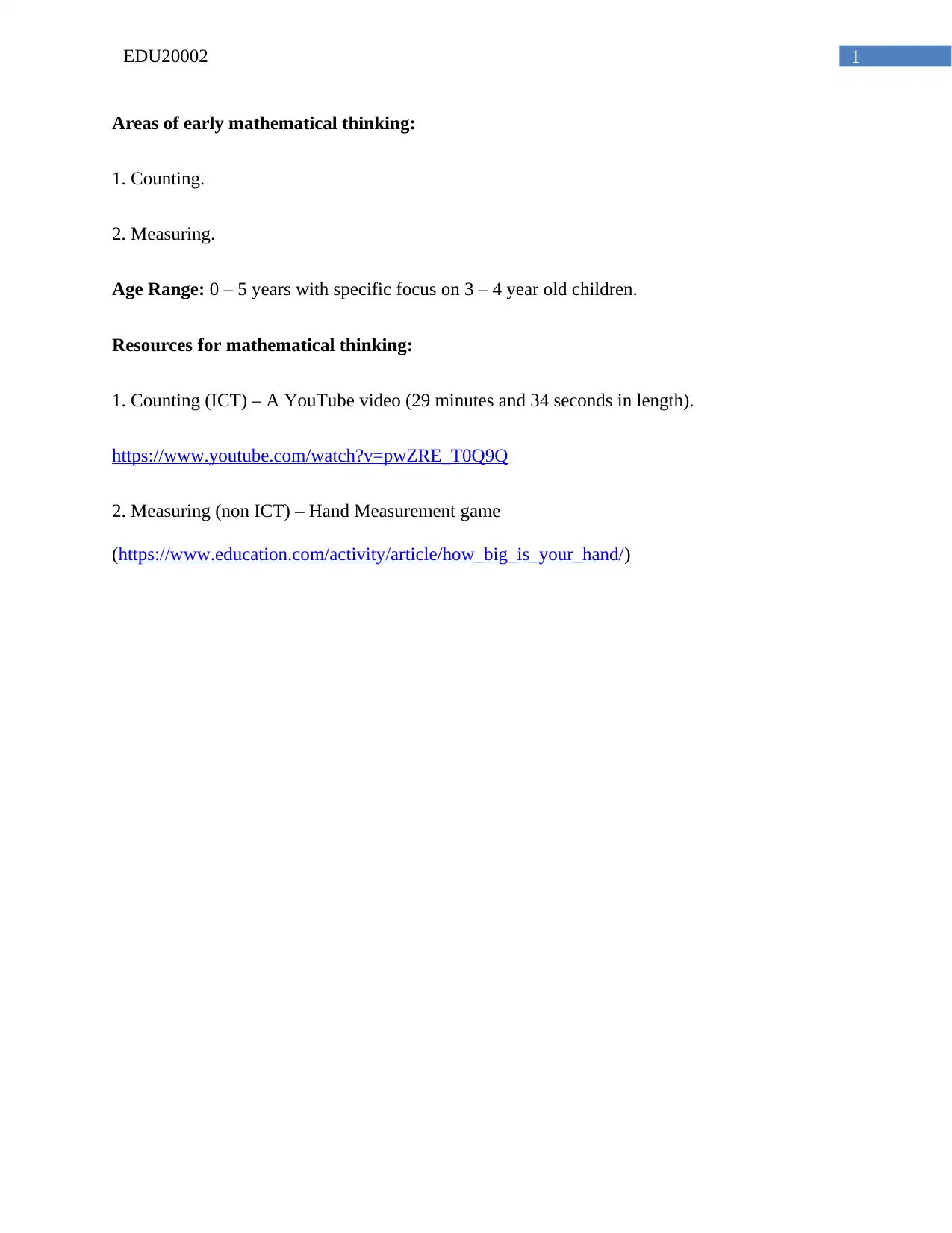
1EDU20002
Areas of early mathematical thinking:
1. Counting.
2. Measuring.
Age Range: 0 – 5 years with specific focus on 3 – 4 year old children.
Resources for mathematical thinking:
1. Counting (ICT) – A YouTube video (29 minutes and 34 seconds in length).
https://www.youtube.com/watch?v=pwZRE_T0Q9Q
2. Measuring (non ICT) – Hand Measurement game
(https://www.education.com/activity/article/how_big_is_your_hand/)
Areas of early mathematical thinking:
1. Counting.
2. Measuring.
Age Range: 0 – 5 years with specific focus on 3 – 4 year old children.
Resources for mathematical thinking:
1. Counting (ICT) – A YouTube video (29 minutes and 34 seconds in length).
https://www.youtube.com/watch?v=pwZRE_T0Q9Q
2. Measuring (non ICT) – Hand Measurement game
(https://www.education.com/activity/article/how_big_is_your_hand/)
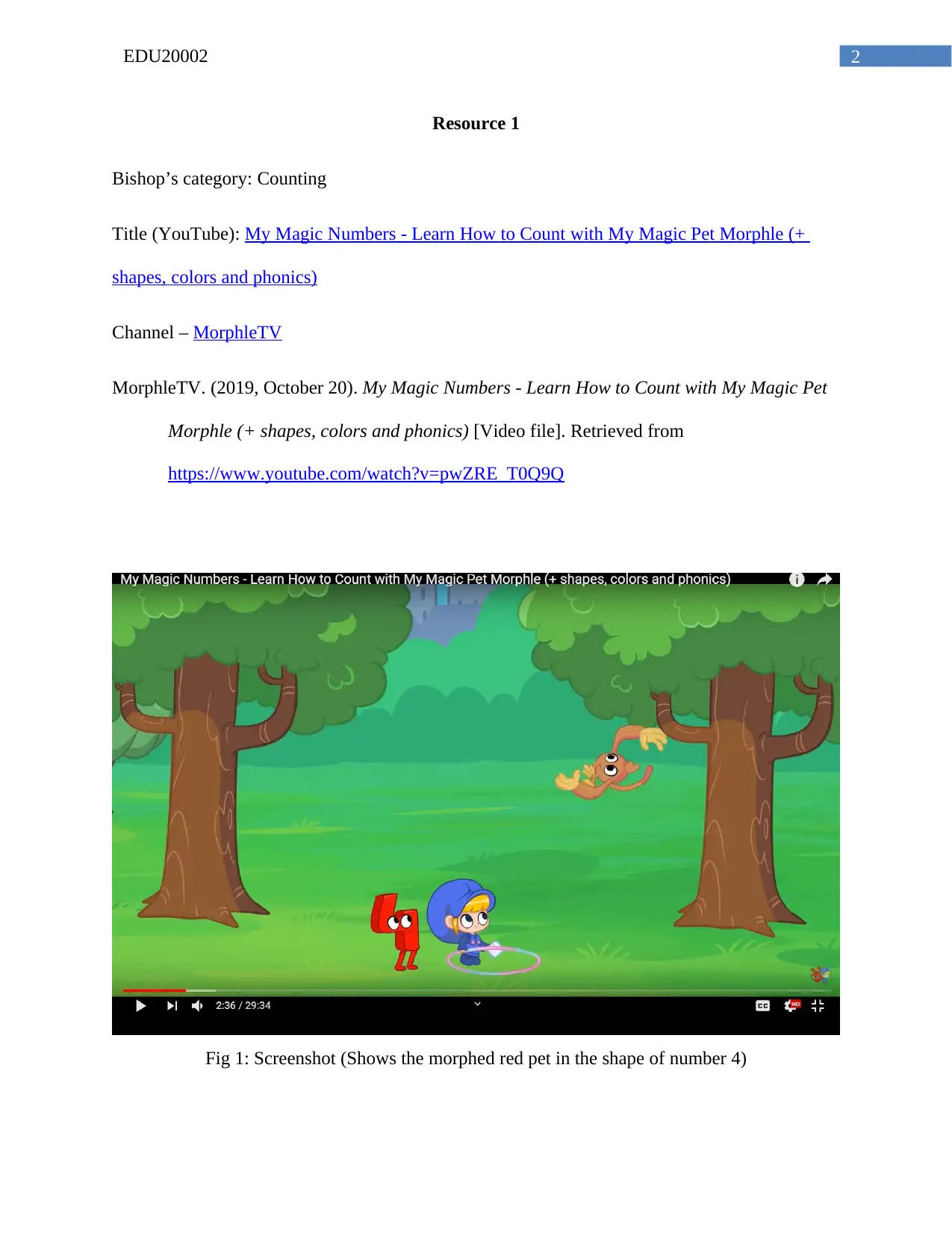
2EDU20002
Resource 1
Bishop’s category: Counting
Title (YouTube): My Magic Numbers - Learn How to Count with My Magic Pet Morphle (+
shapes, colors and phonics)
Channel – MorphleTV
MorphleTV. (2019, October 20). My Magic Numbers - Learn How to Count with My Magic Pet
Morphle (+ shapes, colors and phonics) [Video file]. Retrieved from
https://www.youtube.com/watch?v=pwZRE_T0Q9Q
Fig 1: Screenshot (Shows the morphed red pet in the shape of number 4)
Resource 1
Bishop’s category: Counting
Title (YouTube): My Magic Numbers - Learn How to Count with My Magic Pet Morphle (+
shapes, colors and phonics)
Channel – MorphleTV
MorphleTV. (2019, October 20). My Magic Numbers - Learn How to Count with My Magic Pet
Morphle (+ shapes, colors and phonics) [Video file]. Retrieved from
https://www.youtube.com/watch?v=pwZRE_T0Q9Q
Fig 1: Screenshot (Shows the morphed red pet in the shape of number 4)
⊘ This is a preview!⊘
Do you want full access?
Subscribe today to unlock all pages.

Trusted by 1+ million students worldwide
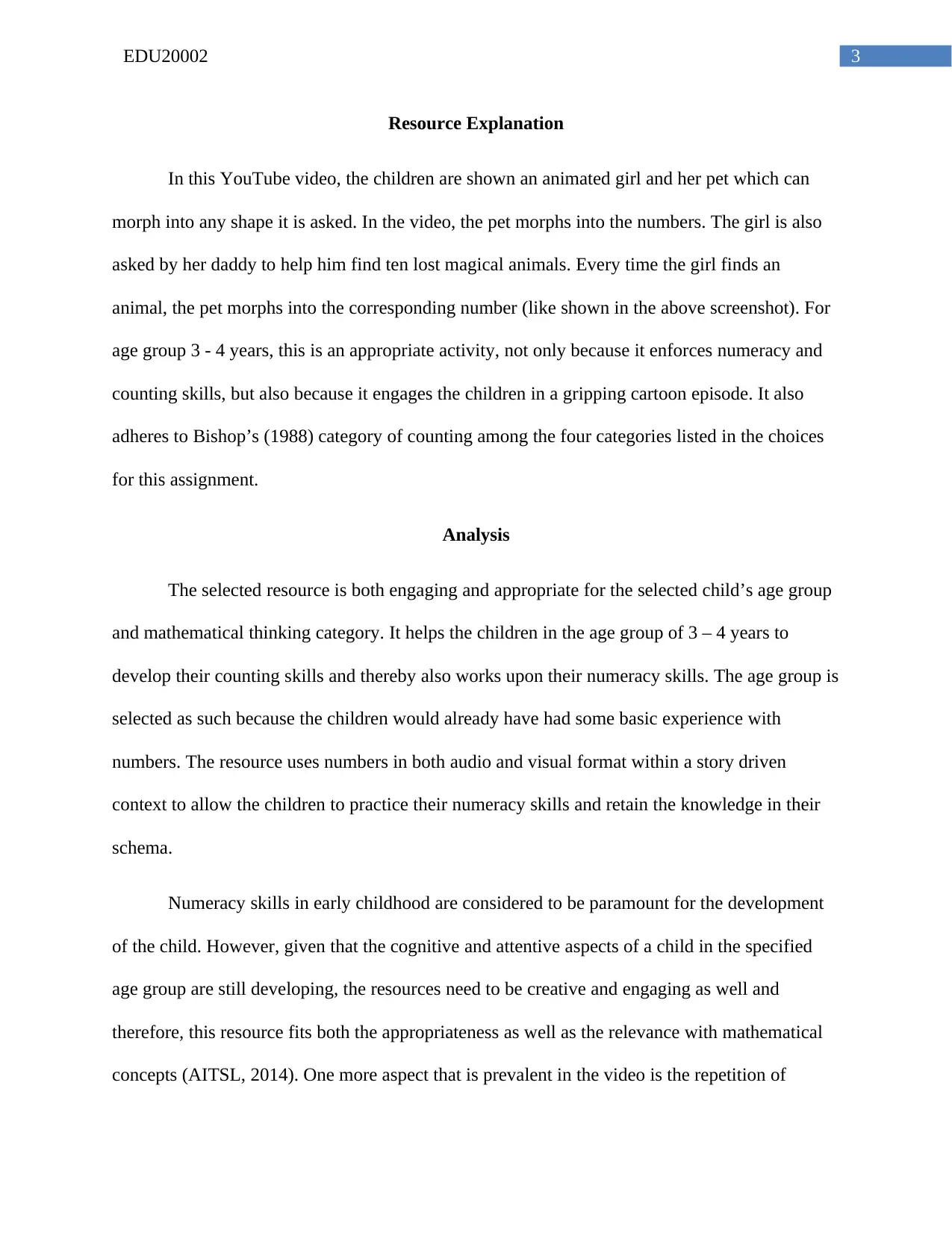
3EDU20002
Resource Explanation
In this YouTube video, the children are shown an animated girl and her pet which can
morph into any shape it is asked. In the video, the pet morphs into the numbers. The girl is also
asked by her daddy to help him find ten lost magical animals. Every time the girl finds an
animal, the pet morphs into the corresponding number (like shown in the above screenshot). For
age group 3 - 4 years, this is an appropriate activity, not only because it enforces numeracy and
counting skills, but also because it engages the children in a gripping cartoon episode. It also
adheres to Bishop’s (1988) category of counting among the four categories listed in the choices
for this assignment.
Analysis
The selected resource is both engaging and appropriate for the selected child’s age group
and mathematical thinking category. It helps the children in the age group of 3 – 4 years to
develop their counting skills and thereby also works upon their numeracy skills. The age group is
selected as such because the children would already have had some basic experience with
numbers. The resource uses numbers in both audio and visual format within a story driven
context to allow the children to practice their numeracy skills and retain the knowledge in their
schema.
Numeracy skills in early childhood are considered to be paramount for the development
of the child. However, given that the cognitive and attentive aspects of a child in the specified
age group are still developing, the resources need to be creative and engaging as well and
therefore, this resource fits both the appropriateness as well as the relevance with mathematical
concepts (AITSL, 2014). One more aspect that is prevalent in the video is the repetition of
Resource Explanation
In this YouTube video, the children are shown an animated girl and her pet which can
morph into any shape it is asked. In the video, the pet morphs into the numbers. The girl is also
asked by her daddy to help him find ten lost magical animals. Every time the girl finds an
animal, the pet morphs into the corresponding number (like shown in the above screenshot). For
age group 3 - 4 years, this is an appropriate activity, not only because it enforces numeracy and
counting skills, but also because it engages the children in a gripping cartoon episode. It also
adheres to Bishop’s (1988) category of counting among the four categories listed in the choices
for this assignment.
Analysis
The selected resource is both engaging and appropriate for the selected child’s age group
and mathematical thinking category. It helps the children in the age group of 3 – 4 years to
develop their counting skills and thereby also works upon their numeracy skills. The age group is
selected as such because the children would already have had some basic experience with
numbers. The resource uses numbers in both audio and visual format within a story driven
context to allow the children to practice their numeracy skills and retain the knowledge in their
schema.
Numeracy skills in early childhood are considered to be paramount for the development
of the child. However, given that the cognitive and attentive aspects of a child in the specified
age group are still developing, the resources need to be creative and engaging as well and
therefore, this resource fits both the appropriateness as well as the relevance with mathematical
concepts (AITSL, 2014). One more aspect that is prevalent in the video is the repetition of
Paraphrase This Document
Need a fresh take? Get an instant paraphrase of this document with our AI Paraphraser
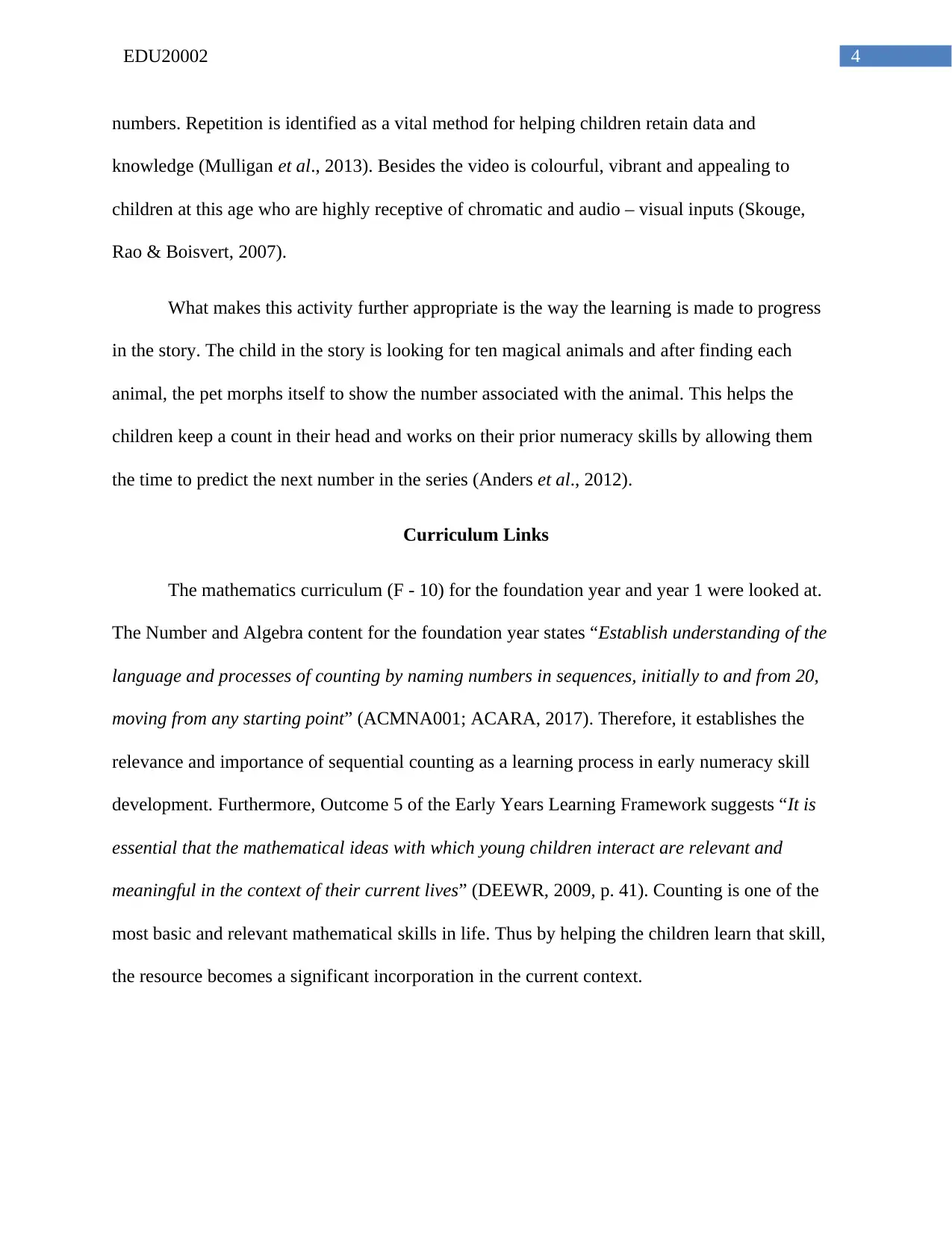
4EDU20002
numbers. Repetition is identified as a vital method for helping children retain data and
knowledge (Mulligan et al., 2013). Besides the video is colourful, vibrant and appealing to
children at this age who are highly receptive of chromatic and audio – visual inputs (Skouge,
Rao & Boisvert, 2007).
What makes this activity further appropriate is the way the learning is made to progress
in the story. The child in the story is looking for ten magical animals and after finding each
animal, the pet morphs itself to show the number associated with the animal. This helps the
children keep a count in their head and works on their prior numeracy skills by allowing them
the time to predict the next number in the series (Anders et al., 2012).
Curriculum Links
The mathematics curriculum (F - 10) for the foundation year and year 1 were looked at.
The Number and Algebra content for the foundation year states “Establish understanding of the
language and processes of counting by naming numbers in sequences, initially to and from 20,
moving from any starting point” (ACMNA001; ACARA, 2017). Therefore, it establishes the
relevance and importance of sequential counting as a learning process in early numeracy skill
development. Furthermore, Outcome 5 of the Early Years Learning Framework suggests “It is
essential that the mathematical ideas with which young children interact are relevant and
meaningful in the context of their current lives” (DEEWR, 2009, p. 41). Counting is one of the
most basic and relevant mathematical skills in life. Thus by helping the children learn that skill,
the resource becomes a significant incorporation in the current context.
numbers. Repetition is identified as a vital method for helping children retain data and
knowledge (Mulligan et al., 2013). Besides the video is colourful, vibrant and appealing to
children at this age who are highly receptive of chromatic and audio – visual inputs (Skouge,
Rao & Boisvert, 2007).
What makes this activity further appropriate is the way the learning is made to progress
in the story. The child in the story is looking for ten magical animals and after finding each
animal, the pet morphs itself to show the number associated with the animal. This helps the
children keep a count in their head and works on their prior numeracy skills by allowing them
the time to predict the next number in the series (Anders et al., 2012).
Curriculum Links
The mathematics curriculum (F - 10) for the foundation year and year 1 were looked at.
The Number and Algebra content for the foundation year states “Establish understanding of the
language and processes of counting by naming numbers in sequences, initially to and from 20,
moving from any starting point” (ACMNA001; ACARA, 2017). Therefore, it establishes the
relevance and importance of sequential counting as a learning process in early numeracy skill
development. Furthermore, Outcome 5 of the Early Years Learning Framework suggests “It is
essential that the mathematical ideas with which young children interact are relevant and
meaningful in the context of their current lives” (DEEWR, 2009, p. 41). Counting is one of the
most basic and relevant mathematical skills in life. Thus by helping the children learn that skill,
the resource becomes a significant incorporation in the current context.
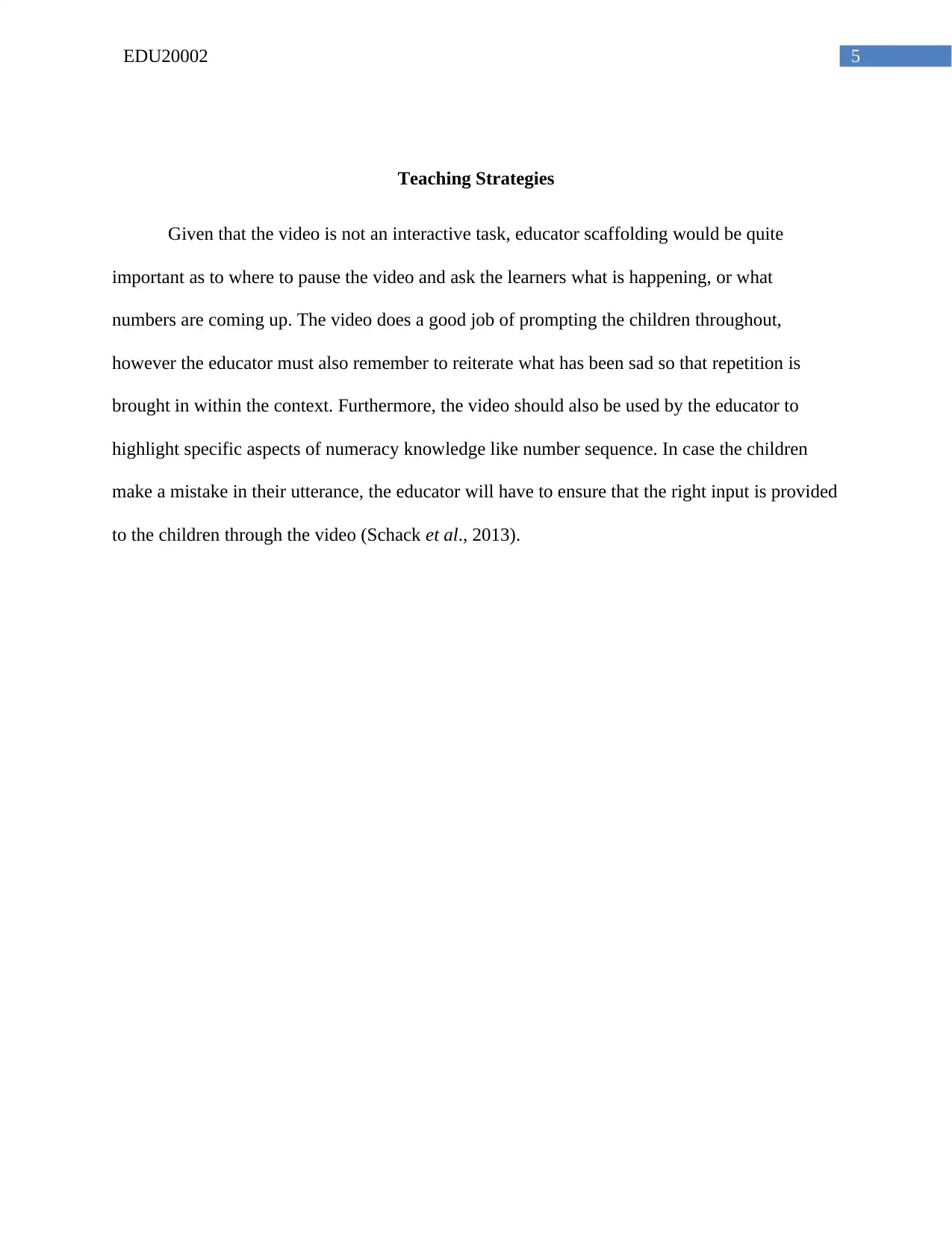
5EDU20002
Teaching Strategies
Given that the video is not an interactive task, educator scaffolding would be quite
important as to where to pause the video and ask the learners what is happening, or what
numbers are coming up. The video does a good job of prompting the children throughout,
however the educator must also remember to reiterate what has been sad so that repetition is
brought in within the context. Furthermore, the video should also be used by the educator to
highlight specific aspects of numeracy knowledge like number sequence. In case the children
make a mistake in their utterance, the educator will have to ensure that the right input is provided
to the children through the video (Schack et al., 2013).
Teaching Strategies
Given that the video is not an interactive task, educator scaffolding would be quite
important as to where to pause the video and ask the learners what is happening, or what
numbers are coming up. The video does a good job of prompting the children throughout,
however the educator must also remember to reiterate what has been sad so that repetition is
brought in within the context. Furthermore, the video should also be used by the educator to
highlight specific aspects of numeracy knowledge like number sequence. In case the children
make a mistake in their utterance, the educator will have to ensure that the right input is provided
to the children through the video (Schack et al., 2013).
⊘ This is a preview!⊘
Do you want full access?
Subscribe today to unlock all pages.

Trusted by 1+ million students worldwide
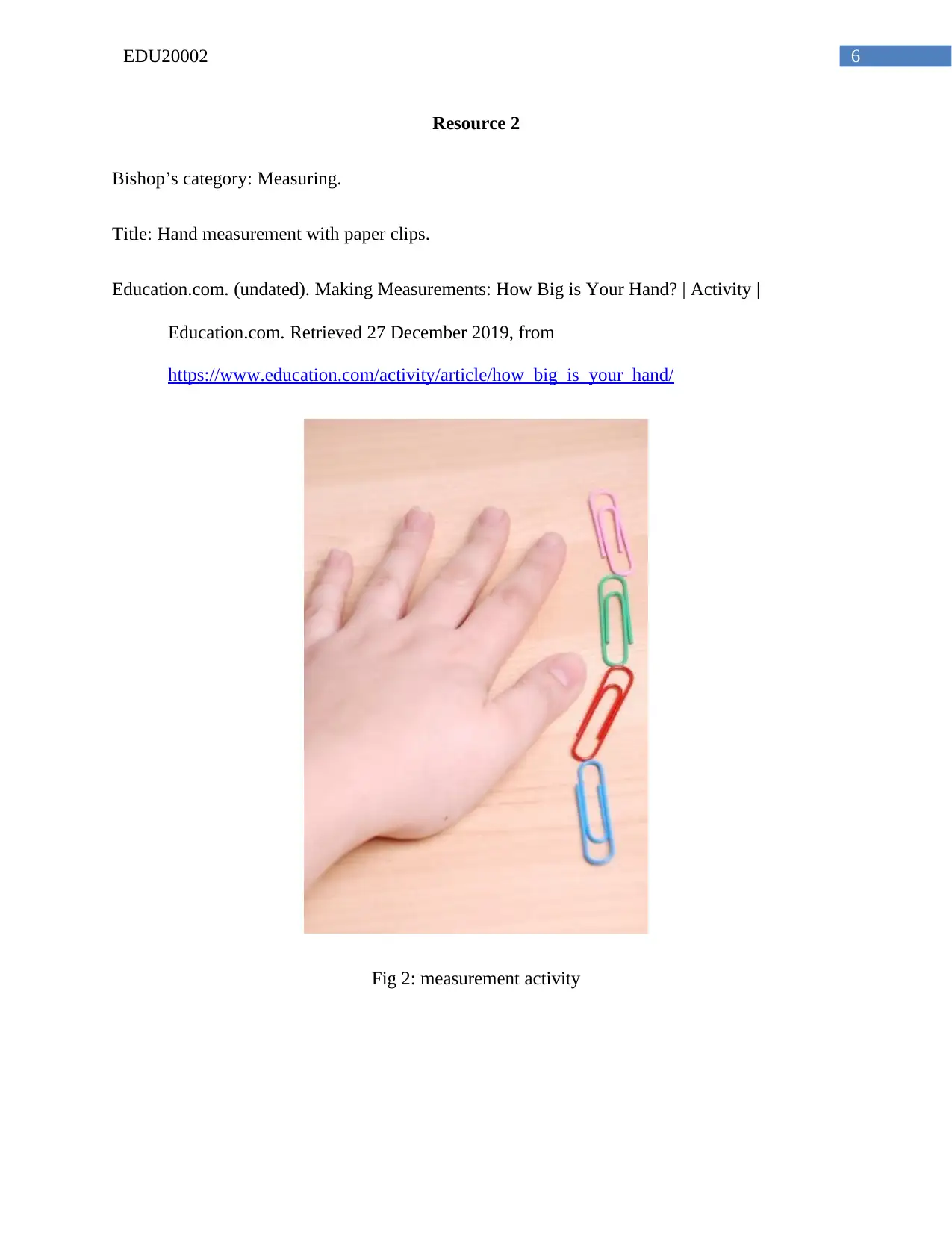
6EDU20002
Resource 2
Bishop’s category: Measuring.
Title: Hand measurement with paper clips.
Education.com. (undated). Making Measurements: How Big is Your Hand? | Activity |
Education.com. Retrieved 27 December 2019, from
https://www.education.com/activity/article/how_big_is_your_hand/
Fig 2: measurement activity
Resource 2
Bishop’s category: Measuring.
Title: Hand measurement with paper clips.
Education.com. (undated). Making Measurements: How Big is Your Hand? | Activity |
Education.com. Retrieved 27 December 2019, from
https://www.education.com/activity/article/how_big_is_your_hand/
Fig 2: measurement activity
Paraphrase This Document
Need a fresh take? Get an instant paraphrase of this document with our AI Paraphraser
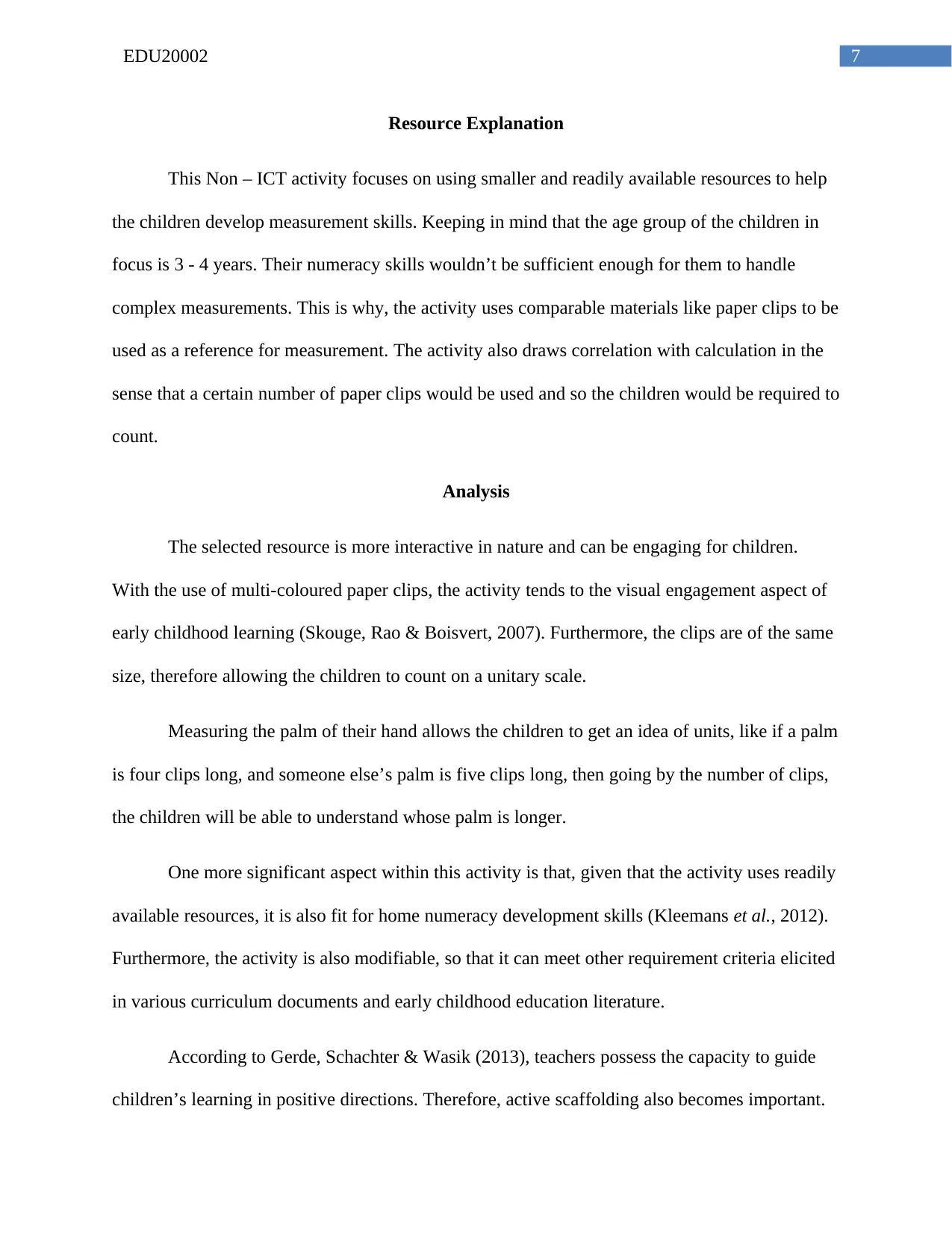
7EDU20002
Resource Explanation
This Non – ICT activity focuses on using smaller and readily available resources to help
the children develop measurement skills. Keeping in mind that the age group of the children in
focus is 3 - 4 years. Their numeracy skills wouldn’t be sufficient enough for them to handle
complex measurements. This is why, the activity uses comparable materials like paper clips to be
used as a reference for measurement. The activity also draws correlation with calculation in the
sense that a certain number of paper clips would be used and so the children would be required to
count.
Analysis
The selected resource is more interactive in nature and can be engaging for children.
With the use of multi-coloured paper clips, the activity tends to the visual engagement aspect of
early childhood learning (Skouge, Rao & Boisvert, 2007). Furthermore, the clips are of the same
size, therefore allowing the children to count on a unitary scale.
Measuring the palm of their hand allows the children to get an idea of units, like if a palm
is four clips long, and someone else’s palm is five clips long, then going by the number of clips,
the children will be able to understand whose palm is longer.
One more significant aspect within this activity is that, given that the activity uses readily
available resources, it is also fit for home numeracy development skills (Kleemans et al., 2012).
Furthermore, the activity is also modifiable, so that it can meet other requirement criteria elicited
in various curriculum documents and early childhood education literature.
According to Gerde, Schachter & Wasik (2013), teachers possess the capacity to guide
children’s learning in positive directions. Therefore, active scaffolding also becomes important.
Resource Explanation
This Non – ICT activity focuses on using smaller and readily available resources to help
the children develop measurement skills. Keeping in mind that the age group of the children in
focus is 3 - 4 years. Their numeracy skills wouldn’t be sufficient enough for them to handle
complex measurements. This is why, the activity uses comparable materials like paper clips to be
used as a reference for measurement. The activity also draws correlation with calculation in the
sense that a certain number of paper clips would be used and so the children would be required to
count.
Analysis
The selected resource is more interactive in nature and can be engaging for children.
With the use of multi-coloured paper clips, the activity tends to the visual engagement aspect of
early childhood learning (Skouge, Rao & Boisvert, 2007). Furthermore, the clips are of the same
size, therefore allowing the children to count on a unitary scale.
Measuring the palm of their hand allows the children to get an idea of units, like if a palm
is four clips long, and someone else’s palm is five clips long, then going by the number of clips,
the children will be able to understand whose palm is longer.
One more significant aspect within this activity is that, given that the activity uses readily
available resources, it is also fit for home numeracy development skills (Kleemans et al., 2012).
Furthermore, the activity is also modifiable, so that it can meet other requirement criteria elicited
in various curriculum documents and early childhood education literature.
According to Gerde, Schachter & Wasik (2013), teachers possess the capacity to guide
children’s learning in positive directions. Therefore, active scaffolding also becomes important.
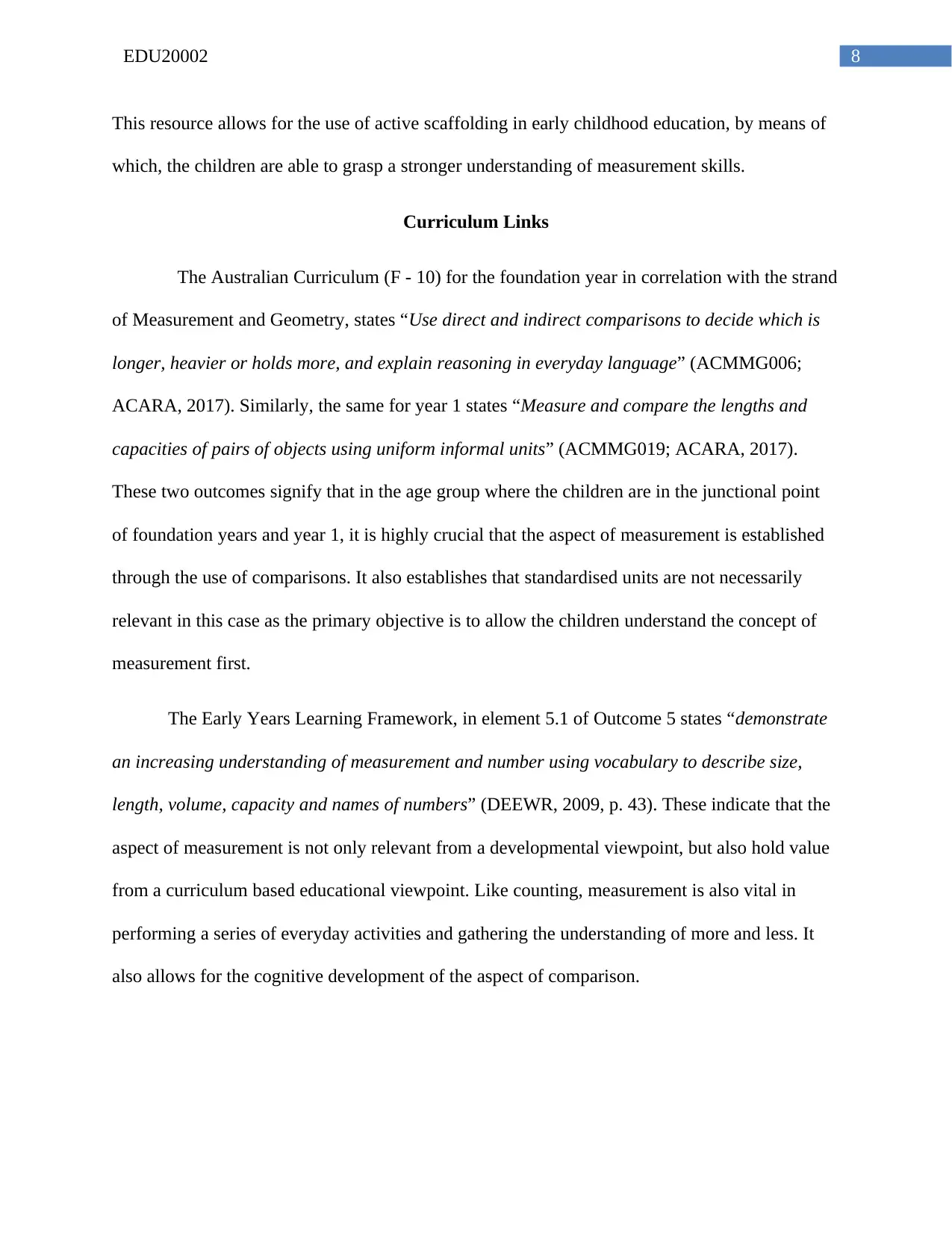
8EDU20002
This resource allows for the use of active scaffolding in early childhood education, by means of
which, the children are able to grasp a stronger understanding of measurement skills.
Curriculum Links
The Australian Curriculum (F - 10) for the foundation year in correlation with the strand
of Measurement and Geometry, states “Use direct and indirect comparisons to decide which is
longer, heavier or holds more, and explain reasoning in everyday language” (ACMMG006;
ACARA, 2017). Similarly, the same for year 1 states “Measure and compare the lengths and
capacities of pairs of objects using uniform informal units” (ACMMG019; ACARA, 2017).
These two outcomes signify that in the age group where the children are in the junctional point
of foundation years and year 1, it is highly crucial that the aspect of measurement is established
through the use of comparisons. It also establishes that standardised units are not necessarily
relevant in this case as the primary objective is to allow the children understand the concept of
measurement first.
The Early Years Learning Framework, in element 5.1 of Outcome 5 states “demonstrate
an increasing understanding of measurement and number using vocabulary to describe size,
length, volume, capacity and names of numbers” (DEEWR, 2009, p. 43). These indicate that the
aspect of measurement is not only relevant from a developmental viewpoint, but also hold value
from a curriculum based educational viewpoint. Like counting, measurement is also vital in
performing a series of everyday activities and gathering the understanding of more and less. It
also allows for the cognitive development of the aspect of comparison.
This resource allows for the use of active scaffolding in early childhood education, by means of
which, the children are able to grasp a stronger understanding of measurement skills.
Curriculum Links
The Australian Curriculum (F - 10) for the foundation year in correlation with the strand
of Measurement and Geometry, states “Use direct and indirect comparisons to decide which is
longer, heavier or holds more, and explain reasoning in everyday language” (ACMMG006;
ACARA, 2017). Similarly, the same for year 1 states “Measure and compare the lengths and
capacities of pairs of objects using uniform informal units” (ACMMG019; ACARA, 2017).
These two outcomes signify that in the age group where the children are in the junctional point
of foundation years and year 1, it is highly crucial that the aspect of measurement is established
through the use of comparisons. It also establishes that standardised units are not necessarily
relevant in this case as the primary objective is to allow the children understand the concept of
measurement first.
The Early Years Learning Framework, in element 5.1 of Outcome 5 states “demonstrate
an increasing understanding of measurement and number using vocabulary to describe size,
length, volume, capacity and names of numbers” (DEEWR, 2009, p. 43). These indicate that the
aspect of measurement is not only relevant from a developmental viewpoint, but also hold value
from a curriculum based educational viewpoint. Like counting, measurement is also vital in
performing a series of everyday activities and gathering the understanding of more and less. It
also allows for the cognitive development of the aspect of comparison.
⊘ This is a preview!⊘
Do you want full access?
Subscribe today to unlock all pages.

Trusted by 1+ million students worldwide
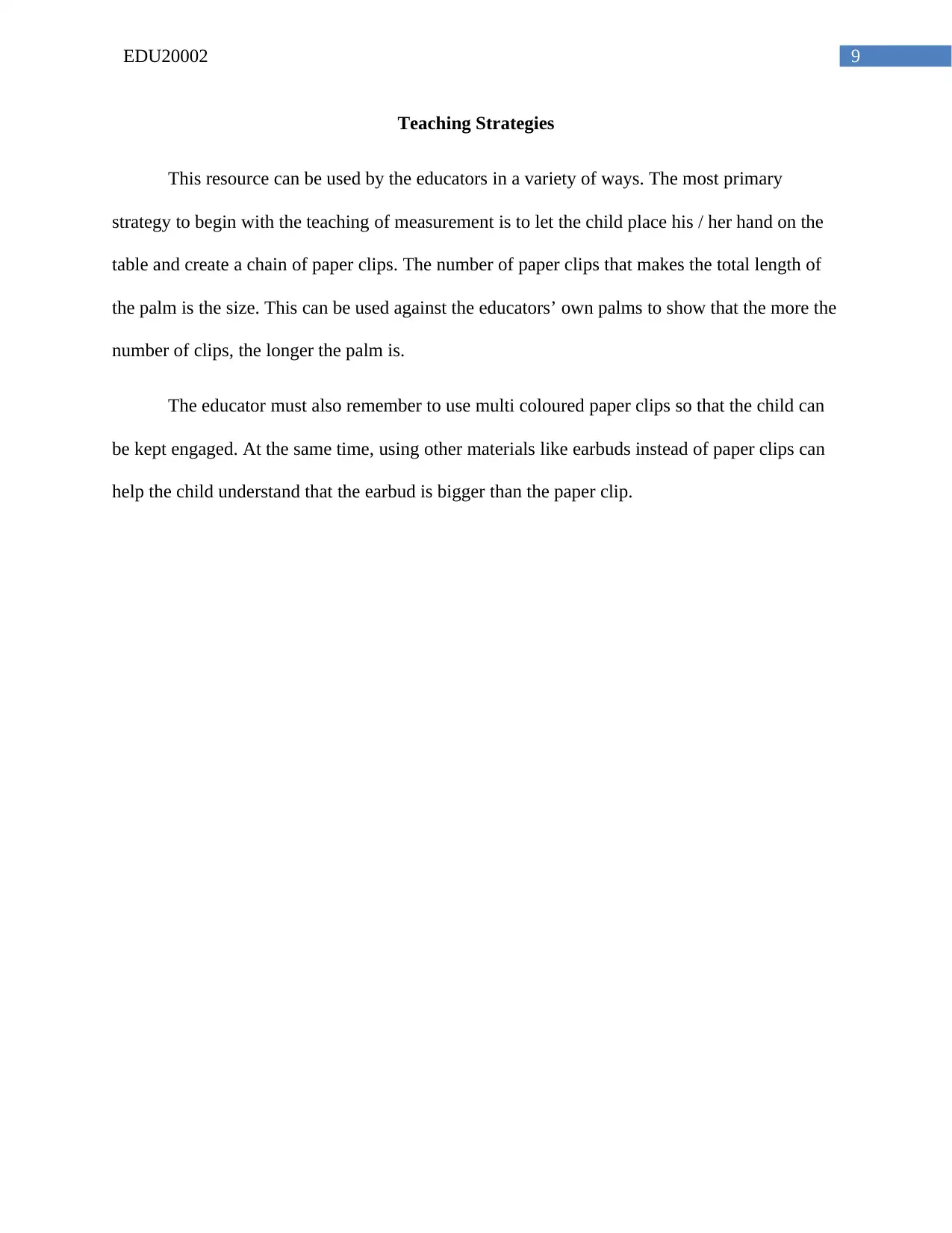
9EDU20002
Teaching Strategies
This resource can be used by the educators in a variety of ways. The most primary
strategy to begin with the teaching of measurement is to let the child place his / her hand on the
table and create a chain of paper clips. The number of paper clips that makes the total length of
the palm is the size. This can be used against the educators’ own palms to show that the more the
number of clips, the longer the palm is.
The educator must also remember to use multi coloured paper clips so that the child can
be kept engaged. At the same time, using other materials like earbuds instead of paper clips can
help the child understand that the earbud is bigger than the paper clip.
Teaching Strategies
This resource can be used by the educators in a variety of ways. The most primary
strategy to begin with the teaching of measurement is to let the child place his / her hand on the
table and create a chain of paper clips. The number of paper clips that makes the total length of
the palm is the size. This can be used against the educators’ own palms to show that the more the
number of clips, the longer the palm is.
The educator must also remember to use multi coloured paper clips so that the child can
be kept engaged. At the same time, using other materials like earbuds instead of paper clips can
help the child understand that the earbud is bigger than the paper clip.
Paraphrase This Document
Need a fresh take? Get an instant paraphrase of this document with our AI Paraphraser
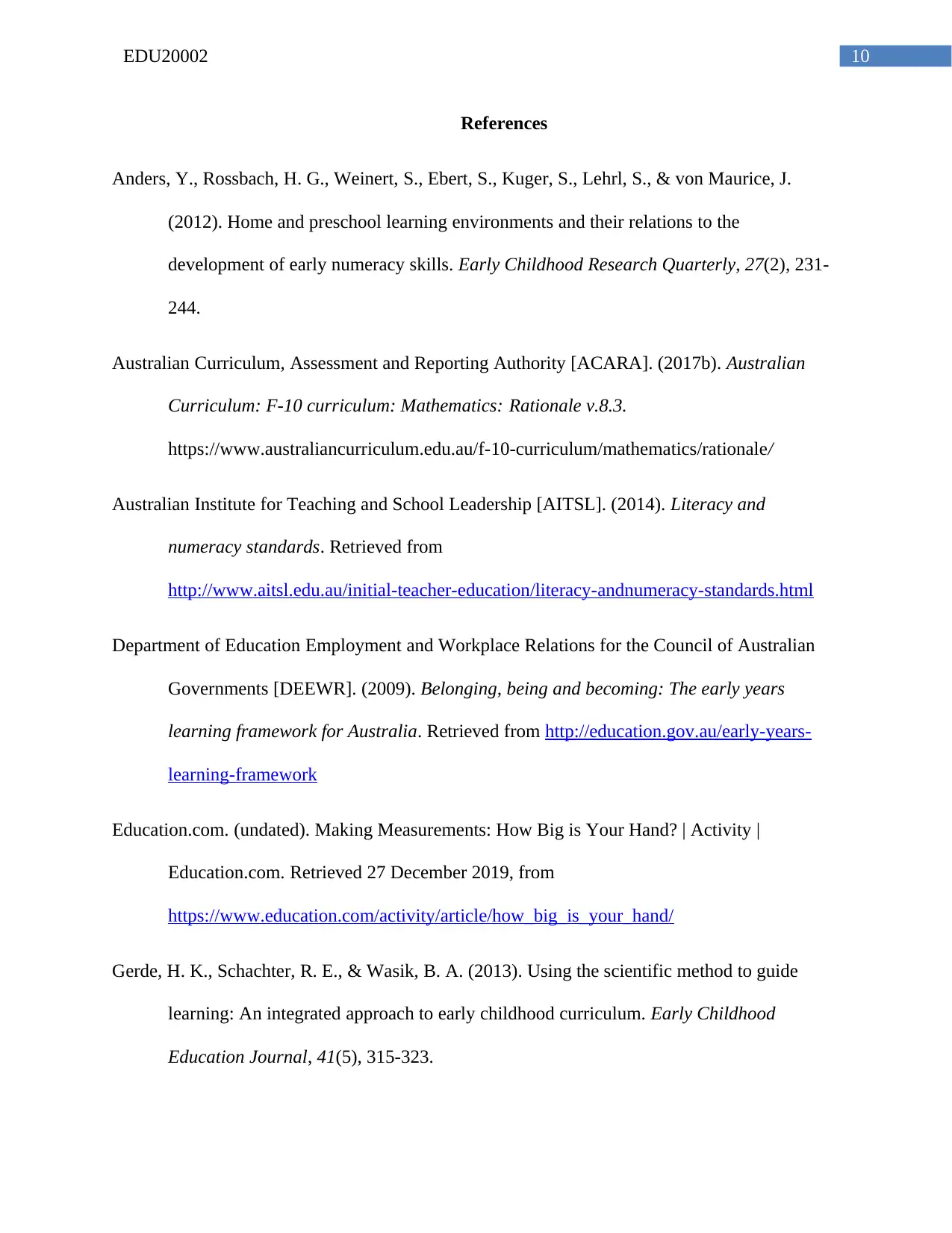
10EDU20002
References
Anders, Y., Rossbach, H. G., Weinert, S., Ebert, S., Kuger, S., Lehrl, S., & von Maurice, J.
(2012). Home and preschool learning environments and their relations to the
development of early numeracy skills. Early Childhood Research Quarterly, 27(2), 231-
244.
Australian Curriculum, Assessment and Reporting Authority [ACARA]. (2017b). Australian
Curriculum: F-10 curriculum: Mathematics: Rationale v.8.3.
https://www.australiancurriculum.edu.au/f-10-curriculum/mathematics/rationale/
Australian Institute for Teaching and School Leadership [AITSL]. (2014). Literacy and
numeracy standards. Retrieved from
http://www.aitsl.edu.au/initial-teacher-education/literacy-andnumeracy-standards.html
Department of Education Employment and Workplace Relations for the Council of Australian
Governments [DEEWR]. (2009). Belonging, being and becoming: The early years
learning framework for Australia. Retrieved from http://education.gov.au/early-years-
learning-framework
Education.com. (undated). Making Measurements: How Big is Your Hand? | Activity |
Education.com. Retrieved 27 December 2019, from
https://www.education.com/activity/article/how_big_is_your_hand/
Gerde, H. K., Schachter, R. E., & Wasik, B. A. (2013). Using the scientific method to guide
learning: An integrated approach to early childhood curriculum. Early Childhood
Education Journal, 41(5), 315-323.
References
Anders, Y., Rossbach, H. G., Weinert, S., Ebert, S., Kuger, S., Lehrl, S., & von Maurice, J.
(2012). Home and preschool learning environments and their relations to the
development of early numeracy skills. Early Childhood Research Quarterly, 27(2), 231-
244.
Australian Curriculum, Assessment and Reporting Authority [ACARA]. (2017b). Australian
Curriculum: F-10 curriculum: Mathematics: Rationale v.8.3.
https://www.australiancurriculum.edu.au/f-10-curriculum/mathematics/rationale/
Australian Institute for Teaching and School Leadership [AITSL]. (2014). Literacy and
numeracy standards. Retrieved from
http://www.aitsl.edu.au/initial-teacher-education/literacy-andnumeracy-standards.html
Department of Education Employment and Workplace Relations for the Council of Australian
Governments [DEEWR]. (2009). Belonging, being and becoming: The early years
learning framework for Australia. Retrieved from http://education.gov.au/early-years-
learning-framework
Education.com. (undated). Making Measurements: How Big is Your Hand? | Activity |
Education.com. Retrieved 27 December 2019, from
https://www.education.com/activity/article/how_big_is_your_hand/
Gerde, H. K., Schachter, R. E., & Wasik, B. A. (2013). Using the scientific method to guide
learning: An integrated approach to early childhood curriculum. Early Childhood
Education Journal, 41(5), 315-323.
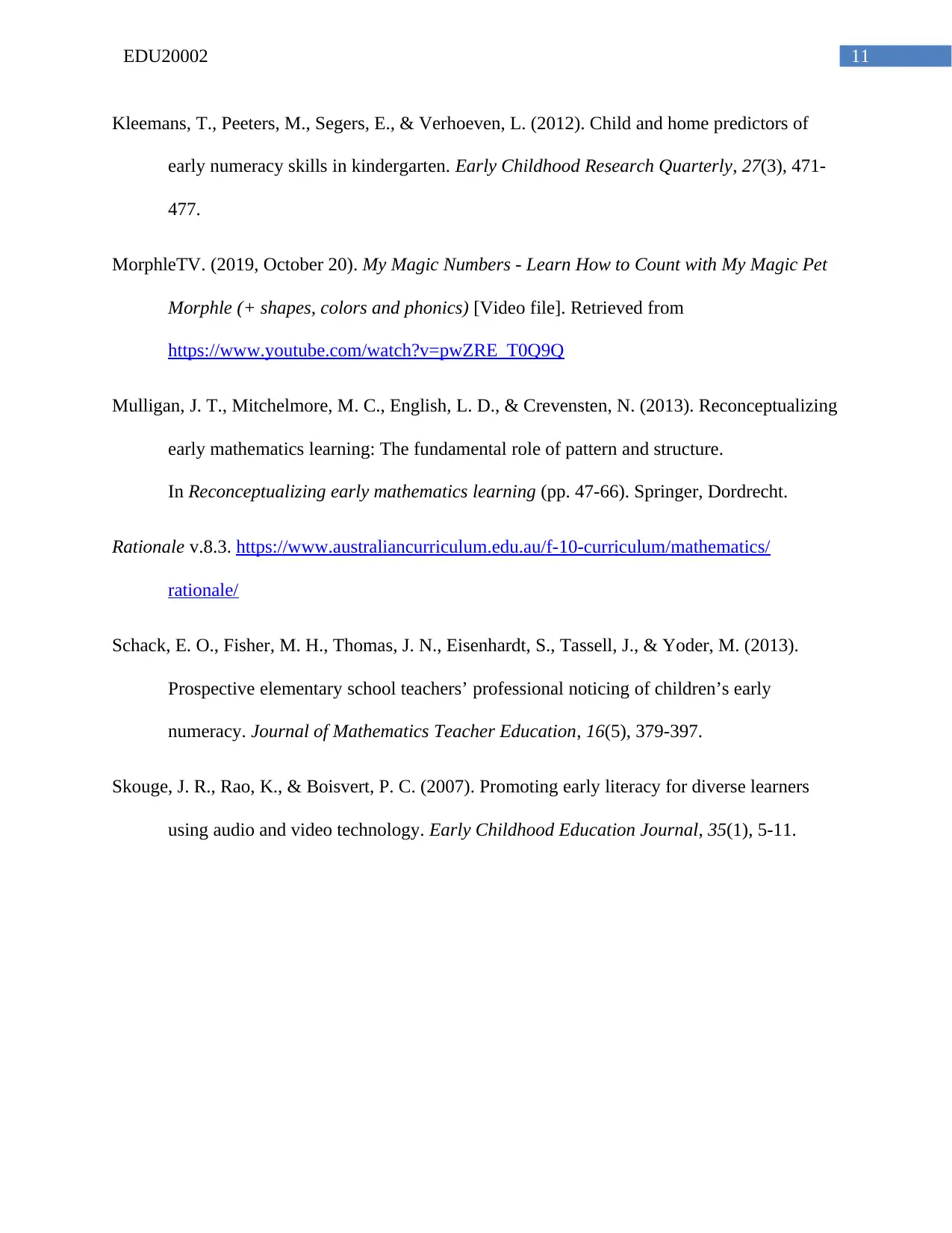
11EDU20002
Kleemans, T., Peeters, M., Segers, E., & Verhoeven, L. (2012). Child and home predictors of
early numeracy skills in kindergarten. Early Childhood Research Quarterly, 27(3), 471-
477.
MorphleTV. (2019, October 20). My Magic Numbers - Learn How to Count with My Magic Pet
Morphle (+ shapes, colors and phonics) [Video file]. Retrieved from
https://www.youtube.com/watch?v=pwZRE_T0Q9Q
Mulligan, J. T., Mitchelmore, M. C., English, L. D., & Crevensten, N. (2013). Reconceptualizing
early mathematics learning: The fundamental role of pattern and structure.
In Reconceptualizing early mathematics learning (pp. 47-66). Springer, Dordrecht.
Rationale v.8.3. https://www.australiancurriculum.edu.au/f-10-curriculum/mathematics/
rationale/
Schack, E. O., Fisher, M. H., Thomas, J. N., Eisenhardt, S., Tassell, J., & Yoder, M. (2013).
Prospective elementary school teachers’ professional noticing of children’s early
numeracy. Journal of Mathematics Teacher Education, 16(5), 379-397.
Skouge, J. R., Rao, K., & Boisvert, P. C. (2007). Promoting early literacy for diverse learners
using audio and video technology. Early Childhood Education Journal, 35(1), 5-11.
Kleemans, T., Peeters, M., Segers, E., & Verhoeven, L. (2012). Child and home predictors of
early numeracy skills in kindergarten. Early Childhood Research Quarterly, 27(3), 471-
477.
MorphleTV. (2019, October 20). My Magic Numbers - Learn How to Count with My Magic Pet
Morphle (+ shapes, colors and phonics) [Video file]. Retrieved from
https://www.youtube.com/watch?v=pwZRE_T0Q9Q
Mulligan, J. T., Mitchelmore, M. C., English, L. D., & Crevensten, N. (2013). Reconceptualizing
early mathematics learning: The fundamental role of pattern and structure.
In Reconceptualizing early mathematics learning (pp. 47-66). Springer, Dordrecht.
Rationale v.8.3. https://www.australiancurriculum.edu.au/f-10-curriculum/mathematics/
rationale/
Schack, E. O., Fisher, M. H., Thomas, J. N., Eisenhardt, S., Tassell, J., & Yoder, M. (2013).
Prospective elementary school teachers’ professional noticing of children’s early
numeracy. Journal of Mathematics Teacher Education, 16(5), 379-397.
Skouge, J. R., Rao, K., & Boisvert, P. C. (2007). Promoting early literacy for diverse learners
using audio and video technology. Early Childhood Education Journal, 35(1), 5-11.
⊘ This is a preview!⊘
Do you want full access?
Subscribe today to unlock all pages.

Trusted by 1+ million students worldwide
1 out of 12
Your All-in-One AI-Powered Toolkit for Academic Success.
+13062052269
info@desklib.com
Available 24*7 on WhatsApp / Email
![[object Object]](/_next/static/media/star-bottom.7253800d.svg)
Unlock your academic potential
Copyright © 2020–2025 A2Z Services. All Rights Reserved. Developed and managed by ZUCOL.
